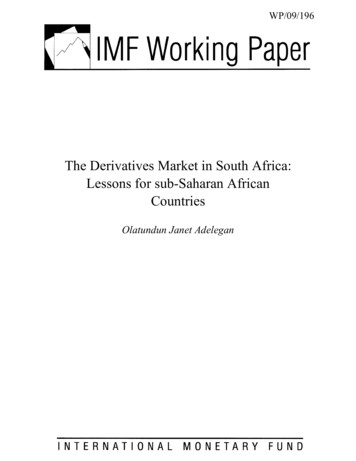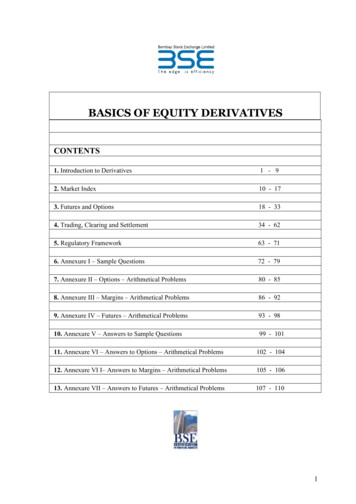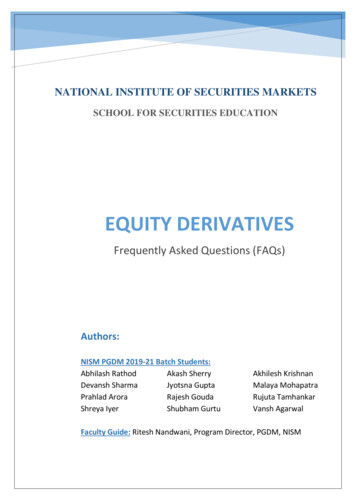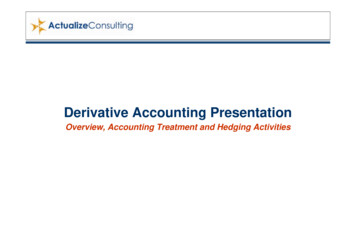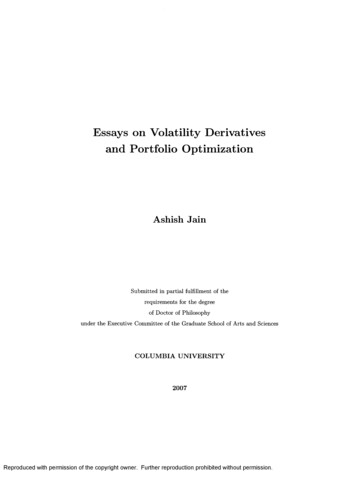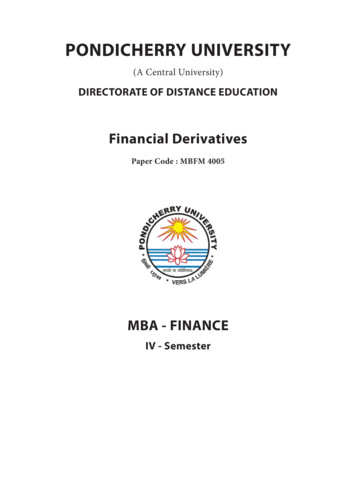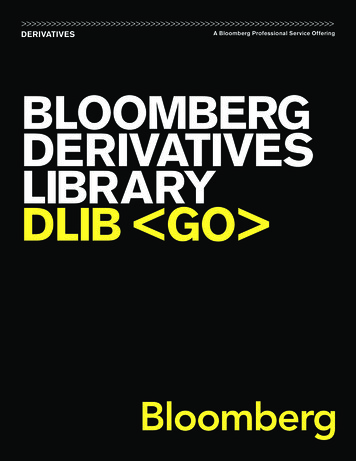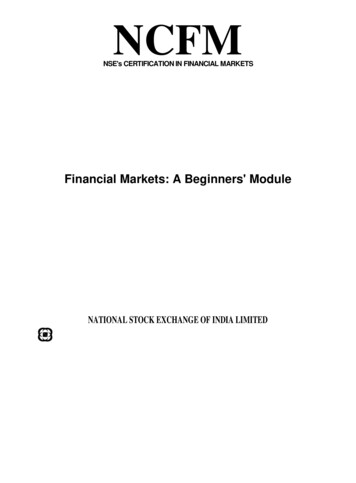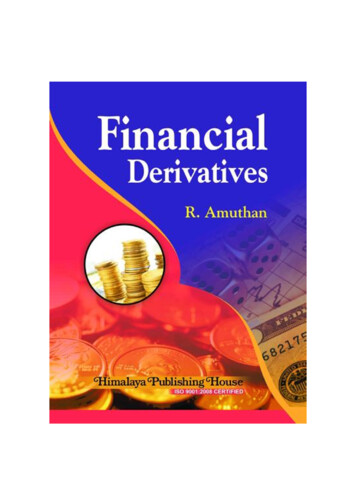
Transcription
Introduction to Financial Derivatives1
2Financial DerivativesFINANCIALDERIVATIVESR. AmuthanM.Com., MBA, M.Phil.,Ph.D. (Finance)Director & Professor,AJK Institute of Management(A Unit of AJK Institutions),Navakkarsi, Coimbatore.First Edition : 2014MUMBAI NEW DELHI NAGPUR BENGALURU HYDERABAD CHENNAI PUNE LUCKNOW AHMEDABAD ERNAKULAM BHUBANESWAR INDORE KOLKATA GUWAHATI
Introduction to Financial Derivatives3 AuthorNo part of this publication may be reproduced, stored in a retrieval system, or transmitted in any formor by any means, electronic, mechanical, photocopying, recording and/or otherwise, without the priorwritten permission of the publishers.First Edition : 2014Published by: Mrs. Meena Pandey for Himalaya Publishing House Pvt. Ltd.,“Ramdoot”, Dr. Bhalerao Marg, Girgaon, Mumbai - 400 004.Phone: 022-23860170/23863863, Fax: 022-23877178E-mail: himpub@vsnl.com; Website: www.himpub.comBranch Offices:New Delhi: “Pooja Apartments”, 4-B, Murari Lal Street, Ansari Road, Darya Ganj,New Delhi - 110 002. Phone: 011-23270392, 23278631; Fax: 011-23256286Nagpur: Kundanlal Chandak Industrial Estate, Ghat Road, Nagpur - 440 018.Phone: 0712-2738731, 3296733; Telefax: 0712-2721216Bengaluru: No. 16/1 (Old 12/1), 1st Floor, Next to Hotel Highlands, Madhava Nagar,Race Course Road, Bengaluru - 560 001.Phone: 080-22286611, 22385461, 4113 8821, 22281541Hyderabad: No. 3-4-184, Lingampally, Besides Raghavendra Swamy Matham, Kachiguda,Hyderabad - 500 027. Phone: 040-27560041, 27550139Chennai: 8/2 Madley 2nd street, T. Nagar, Chennai - 600 017. Mobile: 09320490962Pune: First Floor, "Laksha" Apartment, No. 527, Mehunpura, Shaniwarpeth(Near Prabhat Theatre), Pune - 411 030. Phone: 020-24496323/24496333;Mobile: 09370579333Lucknow: House No 731, Shekhupura Colony, Near B.D. Convent School, Aliganj,Lucknow - 226 022. Phone: 0522-4012353; Mobile: 09307501549Ahmedabad: 114, “SHAIL”, 1st Floor, Opp. Madhu Sudan House, C.G. Road, Navrang Pura,Ahmedabad - 380 009. Phone: 079-26560126; Mobile: 09377088847Ernakulam: 39/176 (New No: 60/251) 1st Floor, Karikkamuri Road, Ernakulam, Kochi – 682011.Phone: 0484-2378012, 2378016; Mobile: 09387122121Bhubaneswar: 5 Station Square, Bhubaneswar - 751 001 (Odisha).Phone: 0674-2532129, Mobile: 09338746007Indore: Kesardeep Avenue Extension, 73, Narayan Bagh, Flat No. 302, IIIrd Floor,Near Humpty Dumpty School, Indore - 452 007 (M.P.). Mobile: 09303399304Kolkata: 108/4, Beliaghata Main Road, Near ID Hospital, Opp. SBI Bank,Kolkata - 700 010, Phone: 033-32449649, Mobile: 7439040301Guwahati: House No. 15, Behind Pragjyotish College, Near Sharma Printing Press,P.O. Bharalumukh, Guwahati - 781009, (Assam).Mobile: 09883055590, 08486355289, 7439040301DTP by: SanhitaPrinted at: M/s. Charita Impressions, Hyderabad on behalf of HPH.
4Financial DerivativesPrefaceThis book is intended for all students of MBA (Finance) of various universities and managementinstitutes and the same can be used for CA, ICWA and ACS courses. The objectives of the bookare to provide the student with a conceptual framework of financial decisions taken with regard toinvestment decisions in Derivative Market. This Derivative Market covers Equity, Foreign Exchangeand Commodity products. The purpose is to make students familiar with the unique economicfundamentals and financial factors, which challenge the financial manager in the international context.The book covers the entire syllabus as approved by UGC on the subject of Financial Derivatives.With increasing prospects on capital market and earnings through hedging, Derivative instrumentsassume significance. This book could be the perfect guide for the beginners who wish to invest inF&O (Futures and Options) segment. Besides, this book is presented in simple mathematical terms,easily understandable to the average students.This has the advantage of harmonising the finance function with the investment function ofthe financial manager on the one hand and integrating the domestic finance with international financeon the other. At the cost of repetition, each chapter is made self-contained and related to otherchapters. But this is an added advantage to students who get a recap of some of the points ofsignificance.The material is kept as brief as possible, yet with a comprehensive coverage of all the modulesas approved by various universities and autonomous institutions and in accordance with their syllabus.This text book could be the perfect guide to the new beginners who want to know aboutDerivative Market in three classifications namely Equity Derivatives, Currency Derivatives andCommodity Derivatives.Author
Introduction to Financial Derivatives5AcknowledgementsI like to express my heartfelt gratitude and countless thanks to P. Krishna Das, Advocate andManaging Trustee, Nehru Group of Institutions, Coimbatore, for his kind support to complete thisbook.I will be failing in my duty, if am not thanking Dr. P. Krishna Kumar, MBA, Ph.D., ChiefExecutive Officer and Secretary of Nehru Group of Institutions, Coimbatore, due to his immenseinvolvement in promoting teaching and Research in Management Education.I am very thankful to Mr. Ajeet Kumar Lalmohan, Secretary and Managing Trustee, AJKInstitution, Coimbatore, for his encouragement and positive motivation.I am very grateful to the Principal, Nehru Institute of Information Technology and ManagementCoimbatore, Dr. R. Moses Daniel, MBA, Ph.D. without whose insiration, this task could have neverbeen possible.I wish to express my gratitute to Dr. R. Nanda Gopal, Director, PSG Institute of Management,Coimbatore, for his invaluable guidance on choosing Finance as the focus of specialisation.I express my thanks to Mr. S. Chandra Sekar, Librarian, PSGIM, Mrs. A. Geetha, AssistantLibrarian, PSGIM, Coimbatore, for their worthy supply of books, materials and online Journals incompleting this book successfully.Finally, I express heartfelt thanks to my father and friends, co-staff members and my studentson giving away all kids of motivation and cooperation in completing this book successfully.R. Amuthan
6Financial DerivativesContents1.Introduction to Financial Derivatives2.Futures Trading35 – 813.Options Trading Mechanism82 – 954.Option Pricing96 – 1655.Swap Markets166 – 1996.Futures Markets – Pricing and Trading Mechanism200 – 2367.Forwards Market237 – 2448.Derivatives in International Business245 – 2499.Regulatory Framework250 – 26310. Case Studies on Mismanagement of DerivativesTrading Practice1 – 34264 – 271Glossary272 – 282Bibliography283 – 284Appendix285 – 290
Introduction to Financial DerivativesCHAPTER17Introduction toFinancialDerivativesDerivatives are instruments in respect of which trading is carried out as a right on an underlyingasset. In normal trading, an asset is acquired or sold. When we deal with derivatives, the asset itselfis not traded, but the right to buy or sell the asset is traded. Thus, a derivative instrument does notdirectly result in a trade but gives a right to a person which may ultimately result in trade. A buyerof a derivative gets a right over the asset which, after or during a particular period of time, mightresult in the buyer buying or selling the asset.A derivative instrument is based on an underlying asset. The asset may be a commodity, a stockor a foreign currency. A right is bought either to buy or sell the underlying asset after or duringa specified time. The price at which the transaction is to be carried out is also spelt out in the beginningitself.The emergence of the market for derivative products, most notably forwardss, futures andoptions, can be traced back to the willingness of risk-averse economic agents to guard themselvesagainst uncertainties arising out of fluctuations in asset price. By their very nature, the financialmarkets are marked by a very high degree of volatility. Through the use of derivative products, itis possible to transfer partially or fully price risks by locking-in asset prices. As instruments of riskmanagement, these generally do not influence the underlying asset prices. However, by locking-inasset prices, derivative products minimise the impact of fluctuations in asset prices on the profitabilityand cash flow situation of risk-averse investors.DERIVATIVES DEFINEDDerivative is a product whose value is derived from the value of one or more basic variables,called bases (underlying asset, index, or reference rate), in a contractual manner. The underlyingasset can be equity, forex, commodity or any other asset. For example, wheat farmers may wishto sell their harvest at a future date to eliminate the risk of a change in prices by that date. Sucha transaction is an example of a derivative. The price of this derivative is driven by the spot priceof wheat which is the “underlying”.(1)
8Financial DerivativesIn the Indian context the securities contracts (Regulation) Act, 1956 (SC(R)A) defines"derivative" to include1. A security derived from a debt instrument, share, loan whether secured or under secured,risk instrument or contract for differences or any other form of security.2. A contract, which derives its value from the prices or underlying securities.Derivatives are securities under the SC(R)A and, hence, the trading of derivatives is governedby the regulatory framework under the SC(R)A.Products, Participants and FunctionsDerivative contracts have several variants. The most common variants are forwardss, futures,options and swaps. The following three broad categories of participants - hedger, speculators andarbitrageurs trade in the derivative market. Hedgers face risk associated with the price of an asset.They use futures or options markets to reduce or eliminate this risk. Speculators wish to bet onfuture movements in the price of an asset. Futures and options contract can give them an extraleverage; that is, they can increase both the potential gains and potential losses in a speculative venture.Arbitrageurs are in business to take advantage of a discrepancy between prices in two differentmarkets. If, for example, they see the futures price of an asset getting out of line with the cashprice, they will take offsetting positions in the two markets to lock in profit.Origin of Derivatives MarketsIt is difficult to trace the main origin of futures trading since it is not clearly established asto where and when the first forwards market came into existence. Historically, it is evident that thedevelopment of futures markets followed the development of forwards markets. It is believed thatthe forwards trading has been in existence since 12th century in England and France. Forwards tradingin rice was started in 17th century in Japan, known as Cho-at-Mai a kind (rice trade-on-book)concentrated around Dojima in Osaka, later on the trade in rice grew with a high degree ofstandardisation. In 1730, this market got official recognition from the Tokugawa Shogurate. As such,the Dojima rice market became the first futures market in the sense that it was registered on organisedexchange with the standardised trading norms.The butter and eggs dealers of Chicago Produce Exchange joined hands in 1898 to form theChicago Mercantile Exchange for futures trading. The exchange provided a futures market for manycommodities including pork bellies (1961), live cattle (1964), live hogs (1966), and feeder cattle(1971). The International Monetary Market was formed as a division of the Chicago MercantileExchange in 1972 for futures trading in foreign currencies. In 1982, it introduced a futures contracton the S&P 500 Stock Index. Many other exchanges throughout the world now trade futurescontracts. Among them are the Chicago Rice and Cotton Exchange, the New York Futures Exchange,the London International Financial Futures Exchange, the Toronto Futures Exchange and theSingapore International Monetary Exchange. They grew so rapidly that the number of sharesunderlying the option contracts sold each day exceeded the daily volume of shares traded on theNew York Stock Exchange.The S&P 500 stock indices while the American Stock Exchange trades options on the MajorMarket Stock Index, and the New York Stock Exchange trades options on the NYSE Index. Mostexchanges offering futures contracts now also offer options on these futures contracts. Thus, the
Introduction to Financial Derivatives9Chicago Board of Trades offers options on corn futures, the Chicago Mercantile Exchange offersoptions on live cattle futures, the International Monetary Market offers options on foreign currencyfutures, and so on.The basic cause of forwards trading was to cover the price risk. In earlier years, transportinggoods from one were market to other markets took many months. For example, in the 1800s, foodgrains produced in England were sent through ships to the United States which normally took fewmonths. Sometimes, during this time, the price crashed due to unfavourable events before the goodsreached the destination. In such cases, the producers had to sell their goods at loss. Therefore, theproducers sought to avoid such price-risk by selling their goods forwards, or on a "to arrive" basis.The basic idea behind this move at that time was simply to cover future price risk. On the oppositeside, the speculator or Oiiier commercial firms seeking to offset their price-risk came forwards togo for such trading. In this way, the forwards trading in commodities came into existence.In the beginning, these forwards trading agreements were formed to buy and sell food grainsin the future for actual delivery at Ehe pre-determined price. Later on, these agreements becametransferable, and during the American Civil War period, i.e., 1860 to 1865, it became commonplaceto sell and resell such agreements where actual delivery of produce was not necessary. Gradually,the traders realised that the agreements were easier to buy and sell if the same were standardisedin terms of quantity, quality and. place of delivery relating to food grains. In the nineteenth centurythis activity was centred in Chicago which was the main food grains marketing centre in the UnitedStates. In this way, the modern futures contracts first came into existence with the establishmentof the Chicago Board of Trade (CBOT) in the year 1848, and today, it is the largest futures marketof the world. In 1865, the CBOT framed the general rules for such trading which later on becamea trendsetter for so many other markets.In 1874, the Chicago Produce Exchange was established which provided the market for butter,eggs, poultry, and other perishable agricultural products. In the year 1877, the London Metal Exchangecame into existence, and today, it is the leading market in metal trading both in spot as well asforwards. In the year 1895, the butter and egg dealers withdrew from the Chicago Produce Exchangeto form separately the Chicago Butter and Egg Board, and thus, in 1919 this exchange was renamedas the Chicago Mercantile Exchange (CME) and was reorganised for futures trading. Since then,so many other exchanges came into existence throughout the world, which trade in futures contracts.Although financial derivatives have been in operation since long, they have become a major forcein financial markets in the early 1970s. The basic reason behind this development was the failureof Brettonwood System and the break-down of the fixed exchange rate regime. As a result, a newexchange rate regime, i.e., floating rate (flexible) system, based upon market forces, came intoexistence. But due to pressure of demand and supply on different currencies, the exchange rateswere constantly changing, and often, substantially. As a result, the business firms faced a new risk,known as currency or foreign exchange risk. Accordingly, a new financial instrument was developedto overcome this risk in the new financial environment.Another important reason for the instability in the financial market was fluctuation in the shortterm interests. This was mainly due to the fact that one of the government at that time tried to manageforeign exchange fluctuations through short-term interest rates and by maintaining money supplytargets, but which were contrary to each other. Further, the increased instability of short-term interestrates created adverse impact on long-term interest rates and hence, the instability in bond prices
10Financial Derivativesbecause they are largely determined by long-term interest rates. The result is that it created anotherrisk, named interest rate risk, for both the issuers and the investors of debt instruments.Interest rate fluctuations had not only created instability in bond prices, but also in other longterm assets such as, company stocks and shares. Share prices are determined on the basis of expectedpresent values of future dividends payments discounted at the appropriate discount rate. Discountrates are usually based on long-term interest rates in the market. So increased instability in the longterm interest rates resulted in enhanced fluctuations in the share prices in the stock markets. Further,volatility in stock prices is reflected in the volatility in stock market indices which causes systematicrisk or market risk.In the early 1970s, it was witnessed that the financial markets were highly unstable. As a result,many financial derivatives have emerged as the means to manage the different types of risks statedabove, and also of taking advantage of it. Hence, the first financial futures market was the InternationalMonetary Market, established in 1972 by the Chicago Mercantile Exchange, which was followed bythe London International Financial Futures Exchange in 1982. For further details see the ‘Growthof Futures Market’ in the forthcoming chapter.BENEFITS OF DERIVATIVE MARKET1. First, prices in an organised derivatives market reflect the perception of market participantsabout the future and lead the prices of underlying to the perceived future level. The pricesof derivatives converge with the price of the underlying at the expiration of the derivativecontract. Thus, derivatives help in discovery of future as well as current prices.2. Second, the derivatives market helps to transfer risks from those who have them but maynot like them, to those who have an appetite for them.3. Third, derivatives, due to their inherent nature, are linked to the underlying cash markets.With the introduction of derivatives, the underlying market witnesses higher trade volumesbecause of participation by more players who would not otherwise participate for lack ofan arrangement to transfer risk.4. Fourth, speculative trades shift to a more controlled environment of derivatives market.In the absence of an organised derivatives market, speculators trade in the underlying cashmarkets. Margining, monitoring and surveillance of the activities of various participantsbecome extremely difficult in these kind of mixed markets.5. Fifth, an important incidental benefit that flows from derivatives trading is that it acts asa catalyst for new entrepreneurial activity. The derivatives have a history of attracting manybright, creative, well-educated people with an entrepreneurial attitude. They often energiseothers to create new businesses, new products and new employment opportunities, thebenefit of which are immense.6. Finally, derivatives markets help increase savings and investment in the long run. Transferof risk enables market participants to expand their volume of activity.7. The most important services provided by the derivatives is to control, avoid, shift andmanage efficiently different types of risks, through various strategies like hedging,arbitraging. Spreading etc. Derivatives assist the holders to shiftor suitably modify the risk
Introduction to Financial Derivatives11characteristics of their portfolios. These are specifically useful in highly volatile financialmarket conditions like erratic trading, highly flexible interest rates, volatile exchange ratesand monetary chaos.8. Derivatives serve as barometers of the future trends in prices which result in the discoveryof new prices both on the spot and futures markets. Further, they help in disseminatingconferrer information regarding the futures markets trading of various commodities andsecurities etc., to the society, which enable to discover or form suitable or correct or trueequilibrium prices in the markets. As a result, they assist in appropriate and superiorallocation of resource in the society.9. As we see that, in derivatives trading, no immediate full amount of the transaction is required,because most of them are based on margin trading. As a result, large number of traders,speculator arbitrageurs operates in such markets. So, derivatives trading enhance liquidityand reduce transaction costs in the markets for underlying assets.10. The derivatives assist the investors, traders and managers of large pools of funds to devisestrategies so that they may make proper asset allocation, increase their yields and achieveother investment goals.11. It has been observed from the derivatives trading in the market that the derivatives smoothenout price fluctuations, squeeze the price spread, integrate price structure at different pointof time and remove gluts and shortages in the markets.12. The derivatives trading encourage the competitive trading in the markets, different risktaking preference of the market operators like speculators, hedgers, traders, arbitrageurs,etc. resulting in increase in trading volume in the country. They also attract young investors,professionals an other experts who will act as catalysts to the growth of financial markets.13. Lastly, it is observed that derivatives trading develop the market towards “completemarkets”. Complete market concept refers to that situation where no particular investorsare belter off than others, or patterns of returns of all additional securities are spanned bythe already existing securities in it, or there is no further scope of additional security.14. All said and done, we can say it is the speculators-friendly market.Uses of Financial Derivative1. Spot price is getting converted in to Future prices. It helps in discovering future as wellas current prices.2. Derivatives help to transfer risks from those who dislike to take risk to those who liketo take risks.3. Assured returns attract many investors.4. Investors can ensure normal or speculative or arbitrage profit, whichever they like.5. In futures, the long-buying investors cannot go for putting down stock market pricemovements as it is due to MTM arrangement. So many long contracts in futures and manycall contracts in option will create more open interest for the underlying counter. This openinterest is healthy sign for the stock price appreciation as if it shows many people are willingto buy the stock.
12Financial Derivatives6. Investors can resort to limit their profit or losses by preferring to option contracts.7. Market prices will not be affected by market sentiments.8. Because of margining system, both buying and selling transactions are guaranteed. In NSE,there is a nodal agency called NSCCL (National Securities Clearing Corporation Limited),which takes care delivery of shares and settling payment for both buyers and sellers incash market as well as F&O Market.TYPES OF FINANCIAL DERIVATIVESThe most commonly used derivatives contracts are forwards, futures and options which weshall discuss in detail later. Here, we take a brief look at various derivatives contracts that have cometo be used.ForwardsA forwards contract is a customised contract between two entities, where settlement takes placeon a specific date in the future at today's pre-agreed price.FuturesA futures contract is an agreement between two parties to buy or sell an asset at a certain timein the future asset at a certain price. Futures contracts are special types of forwards contracts inthe sense that the former are standardised exchange-traded contracts.OptionsOptions are of two types-calls and puts. Calls give the buyer the right but not the obligationto buy a given quantity of the underlying asset, at a given price on or before a given future date.Puts give the buyer the right, but not the obligation to sell a given quantity of the underlying assetat a given price on or before a given date.WarrantsOptions generally have lives of up to one year; the majority of options traded on optionsexchanges having a maximum maturity of nine months. Longer-dated options are called warrantsand are generally traded over-the-counter.LEAPSThe acronym LEAPS means Long-term Equity Anticipation Securities. These are options havinga maturity of up to three years.BasketsBasket options are options on portfolios of underlying assets. The underlying asset is usuallya moving average of a basket of assets. Equity index options are a form of basket options.SwapsSwaps are private agreements between two parties to exchange cash-flows in the futureaccording to a prearranged formula. They can be regarded as portfolios of forwards contract. Thetwo commonly used swaps are:
Introduction to Financial Derivatives13 Interest Rate Swaps: These entail swapping only the interest related cash flows betweenthe parties in the same currency. Currency Swaps: These entail swapping both principal and interest between the parties,with the cash-flows in one direction being in a different currency than those in the oppositedirection.SwaptionsSwaptions are options to buy or sell a swap that will become operative at the expiry of theoptions. Thus a Swaption is an option on a forwards swap. Rather than have calls and puts, theSwaptions market has receiver Swaptions and payer Swaptions. A receiver Swaption is an optionto receive fixed and pay floating. A payer Swaption is an option to pay fixed and receive floating.DEVELOPMENT OF EXCHANGE-TRADED DERIVATIVESDerivatives have probably been around for as long as people have been trading with one another.Forwards contracting dates back at least to the 12th century, and may well have been around beforethen. Merchants entered into contracts with one another for future delivery of specified amount ofcommodities at specified price. A primary motivation for pre-arranging a buyer or seller for a stockof commodities in early forwards contracts was to lessen the possibility that large swings wouldinhibit marketing the commodity after a harvest.The following factors have been during the growth of financial derivatives:1. Increased volatility in asset price in financial market,2. Increased integration of national financial markets with the international markets,3. Marked improvement in communication facilities and sharp decline in their costs,4. Development of more sophisticated risk-management tools, providing economic agents awider choice of risk-management strategies, and5. Innovation in the derivatives markets, which optimally combine the risks and returns overa large number of financial assets leading to higher returns, reduced risks as well astransactions cost as compared to individual financial assets.Table 1.1 The Global Derivatives Industry: Outstanding Contracts (in billions)199519961997199819992000Exchange-traded instruments92831001812403139321352214302Interest rate futures and options8618925711221126431166912626Currency futures and options154171161815996Stock index futures and options5115911021120817931580Some OTC instruments177132545327211442595331658244Interest rate swaps and 01723109501Currency swaps and optionsOther instrumentsTotalSource: Bank for International Settlements.
14Financial DerivativesHow to Trade in Derivatives?Trading in derivatives is as simple as trading in cash markets. The same buy and sell conceptis used here, too. However, an investor can only be long in a cash market. In other words, he canonly buy a particular stock and then sell it later. On the other hand, derivatives provide a distinctadvantage of selling a security at a higher price and then buying the same at a lower price. Thisconcept is known as short selling. In other words, dervative products provide an opportunity to makemoney in a rising market as well as falling market by going long (buy low, sell high) and going short(sell high, buy low).In a long or short futures position, there are three settlement contracts at any point in time –near-month mid-month and far-month contracts. For instance, in April 2011, the April, May and Junecontracts will be the near-month, mid-month and far-month series respectively. Each of these contractsexpires on the last Thursday of that particualr month. Typically, the near-month contracts are the mostliquid, accounting for more than 90 per cent of the volumes for most part of that month.Regardless of whether you are a hedger or speculator, you can keep your position open untilthe expiry of the contract. On the day of the expiry, you must square-off (or close) your positionsby reversing the transactions. In other words, sell if you have bought and vice versa. You can alsoroll over (carry forwards) your positions in to the next month series by first closing your positionint the current series and then taking a similar position on inception the next series, after adjustingfor margin and broker commisions.Global Derivative MarketsThe derivatives markets have grown manifold in the last two decades. Table 1.1 presents growthof the derivatives industry. According to the Bank for International Settlements (BIS), the approximatesize of global derivatives market was US 109.5 trillion at end-December 2000. The total estimatednotional amount of outstanding over-the-counter (OTC) contracts stood at US 95.2 trillion at endDecember 2000, an increase of 7.9 per cent over end-December 1999. Growth in OTC derivativesmarket is mainly attributable to the continued rapid expansion of interest rate contracts, whichreflected growing corporate bond ma
3. Options Trading Mechanism 82 - 95 4. Option Pricing 96 - 165 5. Swap Markets 166 - 199 6. Futures Markets - Pricing and Trading Mechanism 200 - 236 7. Forwards Market 237 - 244 8. Derivatives in International Business 245 - 249 9. Regulatory Framework 250 - 263 10. Case Studies on Mismanagement of Derivatives 264 - 271 .

